Elevate Your Ramadan Experience with the Right Dining Set
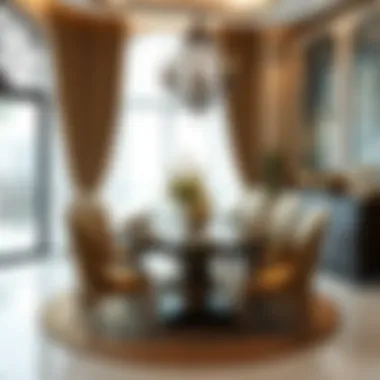
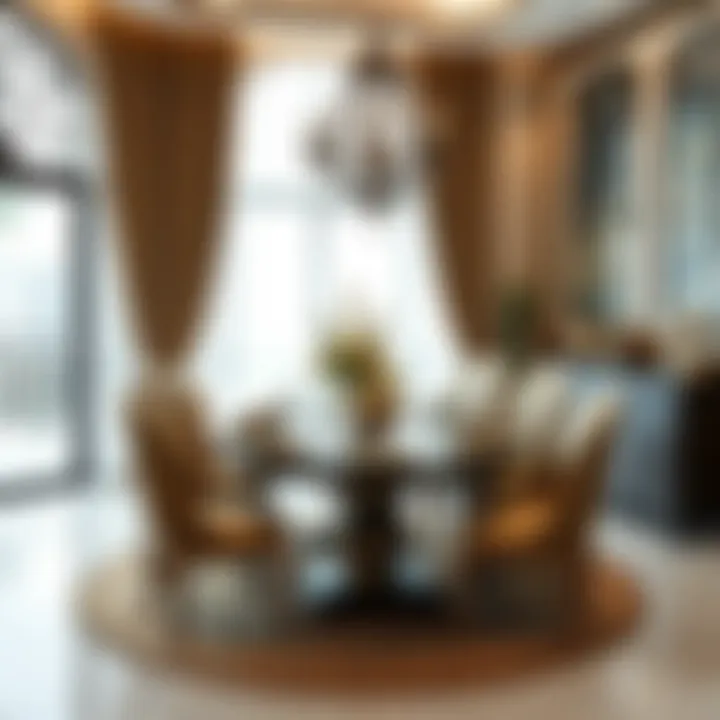
Intro
Ramadan is a special time of year, a period that blossoms with spiritual reflection, family gatherings, and, of course, shared meals. As the sun sets, the dining experience transforms into a celebration of unity and hospitality, where every meal is an opportunity to connect. Choosing the perfect dining set for this month isn't just a matter of aesthetics; it’s an art form that brings together culture, tradition, and personal touch.
In a society rich with diversity, the table is where various tastes and styles converge. From the intricate carvings of wooden sets to the sleek elegance of modern metallic finishes, the range is vast. This guide aims to illuminate the path toward selecting a dining set that not only enhances the visual appeal but also resonates with the essence of Ramadan—a time when family and community hold paramount importance.
Exploring the Essentials of Dining Sets
When delving into the realm of dining sets, one must first recognize the importance of material and design. Each element bears its own subtleties and can dramatically affect the dining experience. For instance, a ceramic set adorned with traditional patterns can evoke a sense of heritage, while glassware adds a modern twist, allowing the vibrant colors of Ramadan dishes to shine through. The right choice ensures your dining area serves both functionality and style, a beautiful backdrop for breaking fast.
Practical Tips on Maintenance and Arrangement
Maintaining your dining set during the month calls for attention. Regular cleaning, especially of delicate materials, keeps the set looking pristine. Additionally, thoughtful arrangement can enhance the dining atmosphere. Collective placement of dishes, utensils, and decor not only creates an inviting space but also speaks volumes about the care taken to honor guests. A well-arranged table is a silent yet powerful statement of warmth and generosity.
Consider incorporating elements that celebrate the spirit of Ramadan. Lanterns or candles can infuse the space with a gentle glow, while fresh dates served on decorative plates lead the way to abundant conversations and laughter.
With this article as your compass, embark on the journey of finding a dining set that tells a story, resonates with your values, and enhances the beautiful experiences we share during this blessed month.
Understanding Ramadan Dining
The essence of Ramadan dining transcends mere nourishment; it encapsulates the spirit of community, gratitude, and spiritual reflection. The month is not only about fasting from dawn until dusk, but it also represents the coming together of families and friends to share meals and strengthen bonds. In this context, understanding Ramadan dining involves grasping its cultural significance and the traditions that enrich the experience.
Cultural Significance
Ramadan is a time steeped in tradition and cultural richness. Families often reunite, and meals shared during this period foster a sense of unity and belonging. The act of breaking fast, known as Iftar, further deepens these connections. It brings an array of culinary delights to the table, symbolizing hospitality. The choice of dining set plays a pivotal role because it is not just about aesthetics; rather, it reflects the values of respect and warmth extended towards guests.
During Ramadan, various foods adorn the dining table, often inspired by heritage. For instance, a family of Middle Eastern descent may serve traditional dishes like date palms and harira, while Southeast Asian families might offer nasi lemak and rendang. Each dish tells a story that resonates with the cultural background, making the selection of dinnerware even more important.
Traditions and Rituals
The rituals associated with Ramadan dining are many, each steeped in significance. The act of setting the table, for instance, isn't simply about placing plates and cutlery; it's a commitment to honoring the traditions passed down through generations. From choosing the right dining set to the arrangements of dishes, every small detail contributes to a larger narrative.
Traditionally, the table might be adorned with intricate designs or colors that symbolize peace and prosperity. Many families also incorporate decorative items, such as lanterns, to illuminate the atmosphere. Embracing such rituals allows individuals to connect with their faith and culture during a time that holds great spiritual importance.
The varied traditions also offer an opportunity to educate younger family members about their rich heritage, ensuring that the essence of Ramadan is passed down. For instance, young children learn to set the table, understanding its importance in nurturing relationships and fostering community spirit. This holistic approach to understanding Ramadan dining is essential for creating not only a meal but a meaningful experience.
"Food is not just about sustenance; it’s a bridge that connects us, especially during sacred times like Ramadan."
In summary, understanding Ramadan dining is paramount for anyone looking to enhance their dining experience during this holy month. By appreciating the cultural significance and engaging in the traditions and rituals associated with it, one can create a distinctive atmosphere that truly resonates with the spirit of Ramadan.
The Importance of a Dining Set
The dining set is more than just a collection of furniture; it’s the heart of the home during the holy month of Ramadan. It serves as a backdrop for gatherings that bring people together, and its significance stretches beyond mere functionality. Choosing the right dining set is about creating an environment that resonates with the spirit of hospitality and unity that Ramadan embodies.
When we think about the dining set, we often focus on its aesthetic appeal. However, its importance also lies in practicality. A well-chosen dining set can adapt to various occasions throughout the month, whether it’s an intimate family Iftar or a larger gathering with friends. The table becomes the focal point where stories are shared, laughter bounces off the walls, and memories are meticulously crafted over delicious meals.
Creating a Welcoming Atmosphere
One of the most critical roles of a dining set is its contribution to creating a warm and welcoming atmosphere. The right set can instantly invite warmth into the space, making guests feel at ease. Think about it: a solid wooden table with intricate carvings can evoke a sense of tradition, while a sleek metal and glass design might reflect modern elegance. The choice of materials and style plays a substantial part in setting the mood.
To enhance that welcoming vibe, consider including elements that resonate with the season. Soft table runners or beautifully designed placemats can add a cozy touch. Candles or lanterns, especially those in rich, vibrant colors, can create an inviting glow as the sun sets and the Iftar begins. The arrangement is equally vital; it shouldn’t just be about laying out the plates and utensils in a hurry. Instead, think about the flow of conversation and comfort for the guests.
Creating that inviting ambience with your dining set sets the stage for meaningful interactions. It's vital to strike the right chord, providing an experience that is both visually pleasing and comfortable. Every detail counts.
Enhancing the Dining Experience
Dining is not just about food, it's about the entire experience that surrounds it. This extends to the dining set, which can significantly enhance this experience during Ramadan. A thoughtful selection of dining sets can help create memorable occasions that linger in the hearts and minds of your loved ones.
Durability of the materials matters, especially when serving multiple courses or hosting large gatherings. A sturdy table and resilient chairs provide peace of mind that they won’t easily damage during hectic meal preparations or lively discussions. Furthermore, consider the ease of cleaning as an essential factor. Surfaces that repel stains and are effortless to wipe down are advantageous, especially after an Iftar gathering.
Also, a well-considered layout of the dining set can add to the dining experience. Tables that allow for casual seating encourage interaction. Including a few cushions or a bench seat can soften the dining area, inspiring comfort and further promoting long, leisurely meals together.
By enhancing the experience, the dining set not only serves food but also fosters connections among those gathered. With the ambiance set just right, it can transform an ordinary meal into something truly unforgettable, giving faithful celebrations greater meaning.
"A dining set is a canvas for the masterpiece of shared moments and heartfelt laughter, painting the essence of Ramadan gatherings."
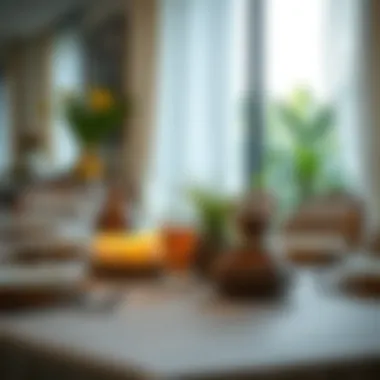
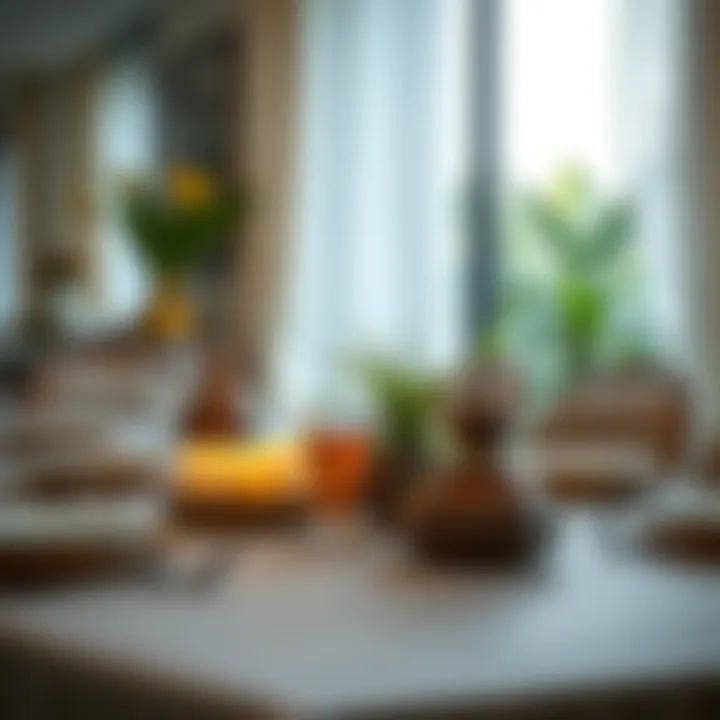
This aspect of the dining set should never be underestimated; it’s where friendships are renewed, where families bond, and where the spirit of Ramadan flourishes in every bite shared and every memory created.
Types of Dining Sets for Ramadan
Choosing the right dining set for Ramadan is more than just a matter of aesthetics; it’s about enhancing the experience of gathering, sharing, and celebration. The dining set carries not only practical value but also cultural weight, inviting family and friends to sit together in moments of togetherness and reflection. When you think about the types of dining sets available, consider how each option can influence the atmosphere and engagement during this holy month. A well-chosen dining set can set the stage for cherished memories and heartfelt connections.
Traditional Designs
Traditional designs in dining sets often reflect the deep-rooted customs and values associated with Ramadan. Think of intricate wood carvings, bold patterns, and hand-painted ceramics that showcase craftsmanship. These elements are more than just decorative; they tell a story. Families who choose traditional designs express their connection to heritage and communal spirit.
When selecting a traditional set, consider how the materials resonate with your cultural background. A wooden dining table made from quality walnut or oak is often seen not just as furniture but as a gathering point for family histories. To enrich your dining experience, aim to incorporate items like ornate serving dishes or intricately designed glasses. These pieces often become talking points, sparking conversations about heritage and favorite meals associated with the season.
"A dining set isn't just a collection of items; it’s the canvas for your Ramadan tales."
Modern Aesthetics
Modern aesthetics cater to a more minimalistic and functional appeal, yet they can still capture the essence of Ramadan. Sleek lines, subtle color palettes, and functional materials create a refreshing atmosphere that still feels welcoming. Think of a glass or metal dining table that complements a vibrant, cozy space filled with cushions and decorative lanterns.
Subtle, modern designs allow host to focus on the food rather than style. You might consider table sets that incorporate sustainable materials like bamboo or recycled composites, aligning with contemporary values of environmental consciousness. Modern aesthetics also provide a versatile backdrop for seasonal decorations, allowing you to switch themes effortlessly as Ramadan progresses. The key with modern designs is to balance simplicity with elements that encourage warmth and connectivity.
Mixing Styles
Mixing styles can be an innovative approach to create a dining set that feels uniquely yours yet resonates with the spirit of Ramadan. This eclectic style allows you to draw from both traditional and modern aesthetics, creating a contrast that tells a personal story. You might find yourself pairing a vintage dining table with contemporary chairs, or mixing ceramic plates with glass serving pieces.
When opting for mixed styles, the challenge lies in ensuring that all elements complement each other. The secret is in the color scheme—selecting hues that create harmony without overshadowing each other. Textiles also offer an excellent way to balance this mix, whether through table runners or napkins that incorporate patterns from different cultures. This approach not only adds visual interest but also honors the diversity found within your community during Ramadan.
By exploring the types of dining sets available, you’ll find that each choice has its advantages, storytelling potential, and connection to personal heritage. Regardless of the style, the truly essential element is how these choices enhance the communal experience during Ramadan, inviting everyone to partake in the joy of sharing food and laughter.
Materials for Dining Sets
When it comes to selecting the perfect dining set for Ramadan, the choice of material is crucial. It not only affects the aesthetics and functionality of the dining area but also reflects the sentiment of sharing and togetherness that is central to Ramadan dining experiences. Various materials bring different characteristics to the table, so it’s important to consider aspects such as durability, maintenance, and how well they mesh with your overall decor. Let's break down some common materials you might choose for your dining set and explore their unique benefits and considerations.
Wooden Dining Sets
Wooden dining sets have been a staple in dining rooms for generations, and for good reason. They bring warmth and sophistication that few other materials can match.
- Durability: A high-quality wooden set is built to last. Hardwoods like oak, walnut, and cherry are particularly known for their resilience. Over time, wood can develop a rich patina that adds to its charm.
- Aesthetic Versatility: Wooden tables fit snugly regardless of your chosen decor style, be it traditional, rustic, or even modern. They can be painted, stained, or left in their natural state, providing a canvas for personalization.
- Cultural Resonance: In many cultures, wooden dining sets carry a significant meaning. They symbolize stability and continuity, much like the family bonds strengthened during Ramadan.
- Considerations: Keep in mind that wood requires regular maintenance to preserve its luster. It may need oils or waxes, especially in humid or dry climates.
Ceramic and Glass Options
Ceramic and glass dining sets offer a modern edge, with their sleek finishes and varied designs. Perfect for those who favor contemporary aesthetics, these materials can transform an ordinary dining area into something extraordinary.
- Variety of Designs: Ceramic and glass can be found in myriad styles and colors, making it easy to align your dining set with your Ramadan theme, whether you’re opting for vibrant hues or minimalist designs.
- Easy to Clean: Both materials are generally easy to maintain. Glass, in particular, can be wiped clean quickly, avoiding any unsightly stains that may develop from shared meals during Iftar.
- Light Reflection: Glass can enhance the lighting in a dining space, reflecting candlelight or string lights, creating a warm ambiance that complements the spirit of gathering.
- Considerations: While beautiful, both ceramic and glass can be fragile. Care during use is essential to avoid breakage, and an inconsiderate bump can definitely ruin a cherished moment.
Metal and Composite Materials
Metal and composite materials, like MDF or engineered wood, introduce a diverse range of choices that can significantly enhance your dining area.
- Modern and Industrial Appeal: Metal can bring an urban feel to a dining space. Steel and aluminum are popular for their sleek designs and robust nature.
- Environmental Considerations: Composite materials, especially those made from recycled wood products, may appeal to the eco-conscious consumer. They often provide a similar appearance to real wood while being more budget-friendly.
- Sturdiness: Metal designs can stand up to wear and tear, making them ideal for households with children or for frequent family gatherings during Ramadan.
- Considerations: Some may find metal sets to lack the warmth of wood, and depending on the design, they can sometimes come across as cold or uninviting.
In summary, the material you choose for your dining set goes beyond mere aesthetics; it speaks volumes about functionality, maintenance, and the values you wish to embody during Ramadan. The right choice can enhance the dining experience and serve as a backdrop for shared moments of joy.
"The dining set holds the essence of familial ties, nourishing both the body and soul during Ramadan."
As you navigate options among wooden, ceramic, glass, metal, and composite materials, think carefully about what resonates with your style, your values, and the overall atmosphere you wish to create. Each material comes with its own story and significance, contributing to the tapestry of Ramadan dining.
Color Schemes and Themes
Choosing the right color schemes and themes for your Ramadan dining setup goes beyond mere aesthetics; it reflects the essence of the season. The ambiance you create sets the stage for warmth and belonging, crucial elements during Ramadan. With gatherings often featuring family and friends, selecting appropriate colors can uplift the mood, ensuring that everyone feels at home. Soft, welcoming tones can encourage conversation, while vibrant colors can energize the atmosphere.
Choosing a Color Palette
When picking a color palette for your Ramadan dining experience, consider hues that resonate with the spirit of this special month. Colors like deep blue, rich gold, and earthy browns are often favored for their association with tradition and hospitality. You might also look into softer pastels for a modern twist, which can provide a feeling of openness and tranquillity. Here are a few tips for selecting the right colors:
- Balance Warm and Cool Tones: Mixing colors such as warm yellows with cooler blues can create a harmonious environment, appealing to various tastes and preferences.
- Reflect Cultural Influences: Take a moment to think about the cultural backgrounds of your guests. Certain colors may hold specific meanings in different cultures, so integrating those can add a layer of respect and thoughtfulness.
- Use Seasonal Inspiration: Nature can be your best friend. Colors associated with Ramadan, like the soft hues seen in desert sunsets, can bring a touch of serenity to your table.
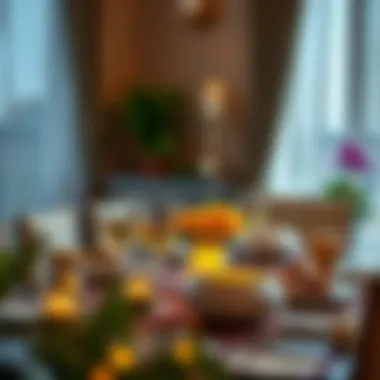
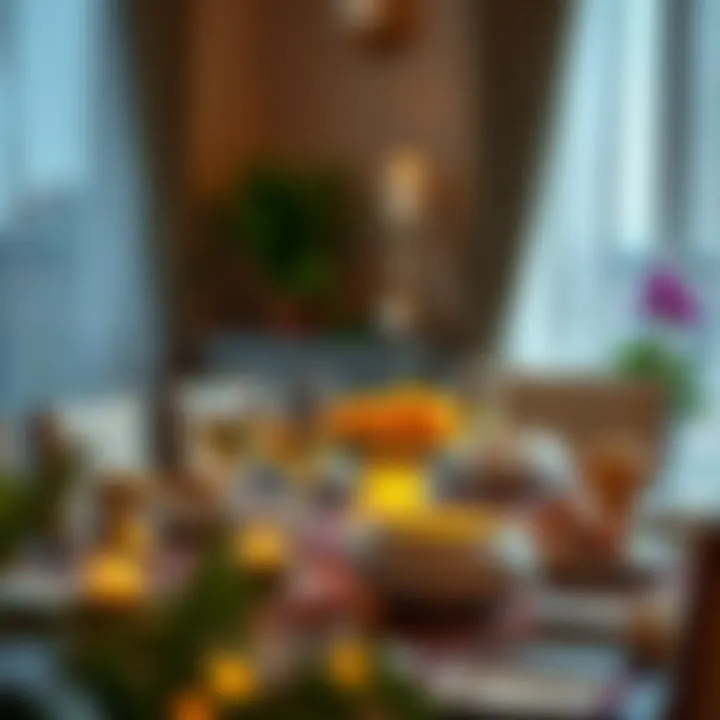
Ultimately, your palette should speak to you, drawing upon personal associations and experiences to build a setting that is both inviting and memorable.
Theme Ideas for Ramadan Gatherings
Crafting a cohesive theme can significantly enhance your dining experience during Ramadan. Below are some innovative ideas that could inspire your setup:
- Tradition Meets Modernity: Blend traditional elements like intricate tablecloths or hand-painted dinnerware with modern centerpieces or minimalist decorations. This juxtaposition beautifully represents the continuity of culture amidst changing times.
- Moonlit Evenings: Consider a theme centered around the moon, which holds special significance during Ramadan. Use silver and navy blue for your color scheme, and incorporate stars in the decor to echo a starlit sky.
- Culinary Journey: Celebrate the delicious diversity of Ramadan meals by capturing the essence of various cuisines. Each course can reflect a different culture, paired with thematic colors and decorations that represent those backgrounds.
Planning a theme brings a tactile element to the dining experience, encouraging your guests to engage more deeply with the moment. Together, the right color schemes and thematic choices transform an ordinary gathering into an extraordinary celebration.
Setting the Table for Iftar
Setting the table for Iftar is not just about laying out plates and utensils; it's an art form grounded in tradition and communal warmth. During Ramadan, each meal symbolizes more than just nourishment; it is a gathering point for family and friends to reflect, share stories, and ultimately strengthen bonds. The importance of making this experience special cannot be overstated, as it lays the groundwork for cherished memories.
When you set the table for Iftar, you are crafting an environment that is inviting. Think of it as a stage where the evening unfolds, spotlighting the splendor of unity. Every element, from the tablecloth to the arrangement of dishes, plays a role in creating a warm atmosphere. A well-set table communicates consideration and effort, both of which enhance the dining experience.
Arranging Place Settings
The art of arranging place settings starts with a clear understanding of how each element contributes to the overall experience.
- Plates and Silverware: Choose plates that speak to the theme of your gathering. Layer them thoughtfully, perhaps starting with a charger plate and progressing inward with dinner and salad plates. Place forks to the left and knives to the right, but don’t stress too much about strict rules; a relaxed setup can be just as charming.
- Glassware: Consider having an array of glasses—one for water, another for juice, and perhaps a decorative one for special drinks. The way these glasses catch light can add an element of elegance.
One should also think about the number of guests. If space is limited, consider using smaller, intimate settings that encourage conversation. The goal is to create not only a functional setup but also a visually appealing one that reflects your personality.
Incorporating Ramadan Decorations
Decorations during Ramadan can add a layer of festivity to your Iftar table. Think of elements that resonate with the spirit of the month, embracing simplicity and elegance.
- Lanterns: These can be a beautiful addition. Place them as centerpieces or along the table edges to create a warm glow. Their light symbolizes the guidance and hope Ramadan brings.
- Crescents and Stars: Using motifs like crescents and stars in your decorations can evoke the month’s celestial significance. These decorations can be subtle, like patterned napkins, or more pronounced, like hanging ornaments.
When incorporating decorations, ensure they do not clutter the table. Leave space for food and conversation; after all, it’s the people that truly make the gathering special.
Table Centerpieces
A centerpiece is perhaps the most visually captivating part of the Iftar table. The goal is to make it stand out while also maintaining balance with the other elements.
- Fruit Displays: Fresh fruit, especially dates, can serve both as decoration and a pre-Iftar snack. Arrange them in a beautiful bowl, combining colors and textures for a feast for the eyes.
- Floral Arrangements: Choose flowers that align with your color scheme. Consider using seasonal blooms, which can bring freshness to the table. Alternatively, herbs like mint or basil in small pots can be aromatic and visually appealing.
Ultimately, the centerpiece serves as the focal point, inviting your guests to gather around. It is an opportunity to express creativity while respecting the essence of Ramadan, making it an inviting space for all.
Maintenance and Care for Dining Sets
Taking care of your dining set during Ramadan is not just about aesthetics; it also reflects the respect you have for the traditions and gatherings associated with this holy month. Proper maintenance ensures that your dining set stands the test of time and continues to enhance the spirit of your festive gatherings.
When you think about the importance of a dining set, remember it serves as a cornerstone for family and friends to come together. It's not merely about what’s placed on the table; it’s about the memories crafted around it. Therefore, by maintaining and caring for your dining set, you’re preserving potential future gatherings and traditions.
Cleaning Techniques
Cleaning your dining set should be a straightforward task, but it deserves careful attention. The first step is identifying the material of your dining set. Different materials require different cleaning methods.
- Wooden Dining Sets: For wood, it's wise to use a damp cloth followed by a dry one. Avoid soaking it, as excessive moisture can warp or damage wood. For stubborn stains, a mix of vinegar and water can help without stripping the finish.
- Ceramic or Glass: These materials can be cleaned with standard dish soap and warm water. Just make sure to dry them immediately to prevent water spots, especially on glass.
- Metal Dining Sets: Use a soft cloth and metal cleaner specific for the type of metal. Avoid abrasive materials that could scratch the surface.
Cleaning isn't just about the physical look but also hygiene, especially during Ramadan, where breaking bread together is a communal activity. Nobody wants dust or stains on their iftar table.
Preserving Material Quality
Once you’ve cleaned your dining set, the next step is preservation. Materials can degrade, lose color, or develop unsightly spots if not properly cared for.
- Wood: Regular polishing can enhance its grain while protecting it from scratches. Use products specifically designed for wooden surfaces. Apply a thin layer and buff with a soft cloth.
- Ceramic and Glass: To maintain their shine, store these items safely to prevent chipping or cracking. For glass, consider using cloths that do not scratch to avoid micro-fine scratches that may develop over time.
- Metal: For metal, regularly check for signs of rust or oxidation, especially if your dining set is outdoors. A cozy garbage bag filled with silica gel packets can help absorb moisture and preserve the quality further.
"A well-kept dining set not only enhances the look of your table but also serves as a silent witness to cherished moments during Ramadan."
In summary, taking the time to clean and maintain your dining set allows you to uphold the spirit of Ramadan and ensure that future gatherings are as memorable and joyful as the ones before. Treat your dining set well, and it will reward you by serving as a beautiful backdrop for your shared meals and celebrations.
Incorporating Technology in Dining Experiences
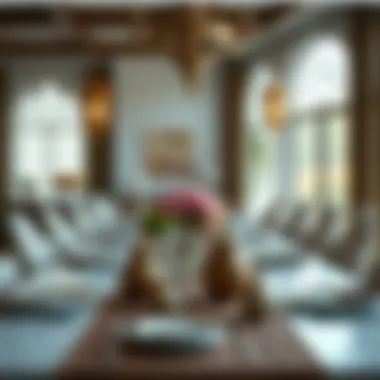

In today’s fast-paced world, the integration of technology into dining experiences has become a game changer, especially during the holy month of Ramadan. The blending of tradition with modern innovation can significantly enhance how we approach meal preparation, hosting, and overall dining ambiance. For many, Ramadan is a time for gathering with loved ones and celebrating community, and technology can elevate these moments, making them not just more convenient, but also more memorable.
Smart Table Settings
The concept of smart table settings might sound like something out of a science fiction novel, but many households are now experiencing it firsthand. Imagine a dining table that automatically adjusts its height for comfort, or even one that can change its color based on the occasion—whether it's a serene Iftar or an elegant Eid gathering. Smart plates equipped with sensors can inform you of portion sizes to help manage dietary needs during fasting.
Additionally, smart lighting can create the right atmosphere, fading in as the sun sets to signal the time for breaking the fast. This is particularly useful during Ramadan, where meals are often communal. You can program lights to shift in warmth and color, enchanting your guests and marking the transition from day to night.
"Technology is not just about devices; it’s about enhancing human experiences and bringing people closer together."
However, one must navigate the balance between technology and maintaining a genuine connection around the dining table. The aim is to enhance interaction rather than distract from it.
Using Apps for Meal Planning
Several meal-planning apps have emerged, designed to simplify the organization of Ramadan meals, especially during the bustling days of fasting. Apps like Mealime or Yummly provide recipe suggestions based on dietary restrictions, preferred ingredients, and even what you have left in your pantry. This can save time and effort as you prepare for Iftar, ensuring no food goes to waste.
Moreover, apps can assist in coordinating responsibilities among family members for meals. Assigning tasks can provide everyone a sense of involvement and foster teamwork. Imagine a shared grocery list app where each family member can add items or mark what they’ve bought—it helps keep everyone in sync.
These technologies not only help in curating a diverse menu reflecting tradition but also ensure that meals are nutritious and varied—essential when breaking a fast. A simple search within these apps can yield hundreds of ideas, transforming your everyday meals into something exciting and special.
In utilizing technology for your dining experiences during Ramadan, consider the authenticity of your gatherings. The goal is to merge the old with the new, allowing for enriching experiences that resonate with the heart of the celebration.
Celebrating Diversity in Dining
Ramadan is not just a time of fasting; it’s also an occasion for togetherness. In many cultures, sharing a meal comes with a tapestry of flavors, traditions, and customs that reflect the rich diversity of their backgrounds. Celebrating diversity in dining is essential because it fosters inclusivity and creates a more vibrant, welcoming atmosphere at the dining table.
Whether you are hailing from different parts of the world or simply embracing various culinary influences, Ramadan dining allows you to present a banquet that mirrors this beautiful blend. This not only enriches the experience for your guests but also deepens your own appreciation of global cuisines.
Fusion Dishes on the Table
When preparing for iftar, consider experimenting with fusion dishes. This is where culinary traditions intersect, giving birth to something unique and delicious. Picture a plate where Mediterranean spices dance with traditional Asian recipes, or perhaps Middle Eastern favorites are indulged with a twist of Latin flavors.
Here are a few examples of delightful fusion dishes:
- Hummus Tacos: A delightful fusion where creamy hummus is spread inside soft tortillas, topped with fresh veggies and spices.
- Samosa Chaat: Crispy samosas served over a bed of spiced yogurt and garnished with crisp onions and coriander, blending South Asian and Middle Eastern flavors.
- Biryani Burritos: Combining fragrant biryani filled in a tortilla, providing a touch of comfort food with a twist.
Fusion dishes appeal to a wide range of palates, capturing the essence of different culinary worlds while still maintaining a sense of familiarity. They stimulate conversation, and who doesn’t appreciate a few creative takes on traditional dishes during such a festive month?
Honoring Different Cultures
Respecting and honoring different cultures during Ramadan is integral. Each culture has its unique way of celebrating* this holy month through food. This includes not just the meals but also how gatherings are conducted and rituals are observed. For instance, in Indonesia, families might gather for a communal meal, while in Egypt, you might find the tradition of welcoming in guests with dates and qamar al-din (apricot juice).
As you set your dining table, take a moment to include elements that pay homage to these cultural traditions. You might:
- Use Traditional Tableware: Incorporate items like Arabesque ceramic plates or Moroccan lanterns to add an authentic touch.
- Highlight Cultural Dishes: Make it a mission to cook or order from local restaurants that specialize in various ethnic cuisines—this could mean Middle Eastern, South Asian, or Turkish dishes aligning with Ramadan.
- Share Stories: Engage guests with stories behind each dish, amplifying a sense of community and shared understanding.
When you honor different cultures, you create a richer dining experience, turning meals into opportunities for learning, sharing, and connecting during the month of Ramadan. By celebrating diversity, your dining experiences become not just meals, but a deeper journey into the heart of various traditions.
Final Thoughts on Ramadan Dining
As the crescent moon graces the sky, signaling the arrival of Ramadan, the preparations for communal meals become more than just a ritual; they transform into a symphony of shared experiences and cherished memories. This period is steeped in significance, encouraging the idea that dining is not merely about breaking bread but fostering connection and celebration. Selecting the perfect dining set plays a pivotal role in enhancing this ambiance. It symbolizes the heart of your home during the month, emphasizing hospitality and warmth.
The dining set holds importance beyond aesthetic appeal; it has practical implications too. Opting for the right materials and designs can not only reflect personal taste but also make it easier to accommodate larger gatherings. For that reason, thinking ahead regarding durability and ease of care can ensure that your set stands the test of time, through multiple Ramadan seasons to come.
In crafting an inviting and pleasant atmosphere, one also fosters a sense of unity among diners. Each item on the table, from plates to glasses, contributes to a cohesive look that invites people to come together. Thus, when selecting your dining set, consider not only how it looks but how it makes everyone feel while gathered around it. The subtleties of equipment choices often speak volumes about the host's intentions and efforts during this sacred month.
“The table is a canvas, and the food, with the perfect dining set, becomes the masterpiece.”
Reflecting on Shared Moments
Reflecting on shared moments during Ramadan fosters gratitude and appreciation. Gathering around a table with family and friends encourages meaningful conversations and revives bonds that may have grown distant. The act of breaking bread together highlights a universal desire for connection, especially in a world that can sometimes feel isolating. During these special gatherings, every story shared adds another layer of richness to the experience, creating treasured memories that last a lifetime.
As plates are filled and laughter fills the air, the dining set plays a crucial role in setting the tone. Whether it's through intricate designs that evoke traditions or modern styles that showcase elegance, the right dining set enhances each moment spent together. Moreover, the ambiance created by thoughtful decoration, such as using themed centerpieces, can elevate even the simplest meal into a remarkable occasion. Time spent around the table is, after all, where relationships flourish.
Looking Ahead to Future Gatherings
Thinking forward in terms of future gatherings can greatly influence how the Ramadan dining experience evolves. Consider how your dining set will serve as a backdrop for celebrations beyond Ramadan, becoming a fixture for all kinds of family and community occasions. Investing in a versatile set with timeless appeal can ensure it remains relevant amidst changing styles and tastes.
Moreover, as families continue to grow, the dynamics of gatherings may shift. An adaptable dining set that can be easily expanded or modified caters to these fluctuations, ensuring that no one feels left out. Mirroring the essence of Ramadan, which emphasizes community and unity, a future-ready dining set embodies the strength of togetherness, laying the foundation for countless special memories.
By holding onto the values of hospitality and generosity, coupled with the beauty and practicality of the chosen dining set, your family can look forward to many festive gatherings filled with good food and even better company. As each year rolls around, let the evolving dining experience reflect the growth in relationships and the bonds formed, highlighting the transformation that comes with every Ramadan.











